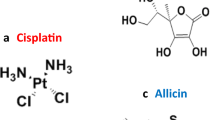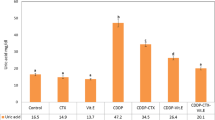Abstract
This study was designed to investigate the role of 7,8-dimethoxycoumarin on cisplatin- and ischemia/reperfusion (I/R)-induced acute renal failure in rats. Acute renal failure was induced in rats by administration of a single dose of cisplatin (CP) (6 mg/kg, intraperitoneally on day 6) and occlusion of the left renal artery for 45 min (I) and opened for the next 24 h (R). The drug samples of 7,8-dimethoxycoumarin (DMC, 50, 75, and 100 mg/kg) and cyclosporin A (50 μM/kg) were administered orally for six consecutive days. Administration of a single dose of cisplatin and I/R event has significantly raised blood urea nitrogen and creatinine, N-acetyl beta-d-glucosaminidase, and thiobarbituric acid reactive substances but decreased FrNa, creatinine clearance, reduced glutathione (GSH), mitochondrial cytochrome c oxidase, and adenosine triphosphate levels. Further, pretreatment of DMC (50, 75, and 100 mg/kg, p.o., for six consecutive days) has ameliorated the CP- and I/R-induced biochemical and histopathological changes in a dose-dependent manner. Furthermore, 75 and 100 mg/kg of 7,8-dimethoxycoumarin has shown to possess the significant renoprotective effect similar to that of the cyclosporin A-treated group which served as positive control. Based on the results of the present study, it has been concluded that 7,8-dimethoxycoumarin protects the kidney against the CP and I/R injury via antioxidant, anti-inflammatory, and inactivation of mitochondrial permeability transition pore opening.



Similar content being viewed by others
References
Ali BH, Al-Moundhri M, Tageldin M, Al Husseini IS, Mansour MA, Nemmar A, Tanira MO (2008) Ontogenic aspects of cisplatin-induced nephrotoxicity in rats. Food Chem Toxicol 46:3355–3359
Armstrong JS (2006) The role of the mitochondrial permeability transition in cell death. Mitochondrion 6:225–234
Atmaca M, Bilgin HM, Obay BD, Diken H, Kelle M, Kale E (2011) The hepatoprotective effect of coumarin and coumarin derivates on carbon tetrachloride-induced hepatic injury by antioxidative activities in rats. J Physiol Biochem 67:569–576
Born SL, Caudill D, Smith BJ, Lehman-McKeeman LD (2000) In vitro kinetics of coumarin 3,4-epoxidation: application to species differences in toxicity and carcinogenicity. Toxicol Sci 58:23–31
Born SL, Api AM, Ford RA, Lefever FR, Hawkins DR (2003) Comparative metabolism and kinetics of coumarin in mice and rats. Food Chem Toxicol 41:247–258
Budzisz E, Brzezinska E, Krajewska U, Rozalski M (2003) Cytotoxic effects, alkylating properties and molecular modelling of coumarin derivatives and their phosphonic analogues. Eur J Med Chem 38:597–603
Carvalho Rodrigues MA, Rodrigues JL, Martins NM, Barbosa F, Curti C, Santos NAG, Santos AC (2010) Carvedilol protects against the renal mitochondrial toxicity induced by cisplatin in rats. Mitochondrion 10:46–53
Casley-Smith JR, Morgan RG, Piller NB (1993) Treatment of lymphedema of the arms and legs with 5,6-benzo-[a]-pyrone. N Engl J Med 329:1158–1163
Chang TS, Gan JL, Fu KD, Huang WY (1996) The use of 5,6 benzo-[alpha]-pyrone (coumarin) and heating by microwaves in the treatment of chronic lymphedema of the legs. Lymphology 29:106–111
Ellman GL (1959) Tissue sulfhydryl groups. Arch Biochem Biophys 82:70–77
Felter SP, Vassallo JD, Carlton BD, Daston GP (2006) A safety assessment of coumarin taking into account species-specificity of toxicokinetics. Food Chem Toxicol 44:462–475
Gill N, Nally JV Jr, Fatica RA (2005) Renal failure secondary to acute tubular necrosis: epidemiology, diagnosis, and management. Chest 128:2847–2863
Girardi JM, Farias RE, Ferreira AP, Raposo NR (2011) Rosuvastatin prevents proteinuria and renal inflammation in nitric oxide-deficient rats. Clinics 66:1457–1462
Guimaraes R, Barros L, Barreira JC, Sousa MJ, Carvalho AM, Ferreira IC (2010) Targeting excessive free radicals with peels and juices of citrus fruits: grapefruit, lemon, lime and orange. Food Chem Toxicol 48:99–106
Hanigan MH, Devarajan P (2003) Cisplatin nephrotoxicity: molecular mechanisms. Cancer Ther 1:47–61
Henry SD, Guarrera JV (2011) Protective effects of hypothermic ex vivo perfusion on ischemia/reperfusion injury and transplant outcomes. Transplant Rev. doi:10.1016/j.trre.2011.09.001
Korthuis RJ, Unthank JL (2000) Experimental models to investigate inflammatory processes in chronic venous insufficiency. Microcirculation 7:S13–S22
Kuriakose GC, Kurup MG (2010) Effects of Aulosira fertilisima against cisplatin-induced nephrotoxicity and oxidative stress in rats. Ren Fail 32:224–233
Lacy A, O’Kennedy R (2004) Studies on coumarins and coumarin-related compounds to determine their therapeutic role in the treatment of cancer. Cur Pharma Des 10:3797–3811
Lake BG (1999) Coumarin metabolism, toxicity and carcinogenicity: relevance for human risk assessment. Food Chem Toxicol 37:423–453
Liu L, Zhu J, Brink PR, Glass PS, Rebecchi MJ (2011) Age-associated differences in the inhibition of mitochondrial permeability transition pore opening by cyclosporine A. Acta Anaesthesiol Scand 55:622–630
Long J, Wang X, Gao H, Liu Z, Liu C, Miao M, Liu J (2006) Malonaldehyde acts as a mitochondrial toxin: inhibitory effects on respiratory function and enzyme activities in isolated rat liver mitochondria. Life Sci 79:1466–1472
Lowry OH, Rosenbrough NJ, Farr AL, Randall RJ (1951) Protein measurement with Folin phenol reagent. J Biol Chem 193:265–275
Murat Bilgin H, Atmaca M, Deniz Obay B, Ozekinci S, Taşdemir E, Ketani A (2011) Protective effects of coumarin and coumarin derivatives against carbon tetrachloride-induced acute hepatotoxicity in rats. Exp Toxicol Pathol 63:325–330
Muthuraman A, Ramesh M, Sood S (2010a) Development of animal model for vasculatic neuropathy: induction by ischemic-reperfusion in the rat femoral artery. J Neurosci Methods 186:215–221
Muthuraman A, Sood S, Gill NS, Arora R (2010b) Therapeutic potential of Emblica officinalis L. fruit extract on ischemia reperfusion injury induced acute renal failure in rat. Lat Am J Pharm 29:1208–1214
Muthuraman A, Ramesh M, Chauhan A (2011a) Mitochondrial dependent apoptosis: ameliorative effect of flunarizine on ischemia-reperfusion of celiac artery-induced gastric lesions in the rat. Dig Dis Sci 56:2244–2251
Muthuraman A, Singla SK, Peters A (2011b) Exploring the potential of flunarizine for cisplatin-induced painful uremic neuropathy in rats. Int Neurourol J 15:127–134
Muthuraman A, Singla SK, Rana A, Singh A, Sood S (2011c) Reno-protective role of flunarizine (mitochondrial permeability transition pore inactivator) against gentamicin induced nephrotoxicity in rats. Yakugaku Zasshi 131:437–443
Muthuraman A, Sood S, Singla SK, Rana A, Singh A, Singh A, Singh J (2011d) Ameliorative effect of flunarizine in cisplatin-induced acute renal failure via mitochondrial permeability transition pore inactivation in rats. Naunyn Schmiedebergs Arch Pharmacol 383:57–64
Okhawa H, Ohishi N, Yagi K (1979) Assay for lipid peroxidation in animal tissue by thiobarbituric acid reaction. Analyt Biochem 95:351–358
Paroni R, de Vecchi E, Lubatti L, Conti E, Beretta C, Rinaldi P, Galli Kienle M, Trazzi R (1995) Influence of the 21-aminosteroid U74389F on ischemia-reperfusion injury in the rat. Eur J Pharmacol 294:737–742
Rauchfuss F, Breuer M, Dittmar Y, Heise M, Bossert T, Hekmat K, Settmacher U (2011) Implantation of the liver during reperfusion of the heart in combined heart-liver transplantation: own experience and review of the literature. Transplant Proc 43:2707–2713
Rustin P, Chretien D, Bourgeron T, Gerard B, Rotig A, Saudubray JM, Munnich A (1994) Biochemical and molecular investigations in respiratory chain efficiencies. Clin Chim Acta 228:35–51
Sauriyal DS, Jaggi AS, Singh N, Muthuraman A (2011) Investigating the role of endogenous opioids and K(ATP) channels in glycerol-induced acute renal failure. Fundam Clin Pharmacol. doi:10.1111/j.1472-8206.2011.00936.x
Schlichting CL, Schareck WD, Weis M (2006) Renal ischemia–reperfusion injury: new implications of dendritic cell–endothelial cell interactions. Transplant Proc 38:670–673
Sehirli O, Sener E, Cetinel S, Yüksel M, Gedik N, Sener G (2008) Alpha-lipoic acid protects against renal ischaemia-reperfusion injury in rats. Clin Exp Pharmacol Physiol 35:249–255
Severinghaus JW, Ferrebee JW (1950) Calcium determination by flame photometry; methods for serum, urine, and other fluids. J Biol Chem 187:621–630
Sood S, Arora B, Bansal S, Muthuraman A, Gill NS, Arora R, Bali M, Sharma PD (2009) Antioxidant, anti-inflammatory and analgesic potential of the Citrus decumana L. peel extract. Inflammopharmacology 17:267–274
Sood S, Muthuraman A, Gill NS, Bali M, Sharma PD (2010) Role of 7,8-dimethoxycoumarin in anti-secretary and anti-inflammatory action on pyloric ligation-induced gastritis in rats. J Asian Nat Prod Res 12:593–599
Stephan K, Chang M, Brass EP, Hoppel CL (1991) Decreased activities of ubiquinol:ferricytochrome c oxidoreductase complex and ferrocytochrome c: oxygen oxidoreductase in liver mitochondria from tats with hydroxycobalamin-induced methylmalonic aciduria. J Biol Chem 266:20998–21003
Takada M, Nadeau KC, Shaw GD, Marquette KA, Tilney NL (1997) The cytokine-adhesion molecule cascade in ischemia/reperfusion injury of the rat kidney. Inhibition by a soluble P-selectin ligand. J Clin Invest 99:2682–2690
Thornes RD (1993) Prevention of recurrence of malignant melanoma by coumarin (1,2-benzopyrone). J Ir Coll Physicians Surg 22:17–19
NTP (National Toxicology Program) (1993) Toxicology and carcinogenesis studies of coumarin in F344/N rats and B6C3F1 mice (gavage study), NTP TR 422. Department of Health and Human Services, National Institutes of Health, Public Health Service, USA
Vecchi ED, Lubatti L, Beretta C, Ferrero S, Rinaldi P, Kienle MG, Trazzi R, Paron R (1998) Protection from renal ischemia-reperfusion injury by the 2-methylaminochroman U83836E. Kidney Int 54:857–863
Voora D, McLeod HL, Eby C, Gage BF (2005) The pharmacogenetics of coumarin therapy. Pharmacogenomics 6:503–513
Wittgen HG, van den Heuvel JJ, van den Broek PH, Siissalo S, Groothuis GM, de Graaf IA, Koenderink JB, Russel FG (2012) Transport of the coumarin metabolite 7-hydroxycoumarin glucuronide is mediated via multidrug resistance-associated proteins 3 and 4. Drug Metab Dispos. doi:10.1124/dmd.111.044438
Xing-mei H, Min H, Quan Z (1999) Effect and mechanism of 6,7 dimethoxycoumarin on acute renal failure. Chinese Pharma J
Acknowledgments
Thanks to all the faculty members of Rayat Institute of Pharmacy for their encouragement and support. We are also grateful to Rayat and Bahra Educational and Research Trust for their unconditional help to carry out this project.
Conflict of interest
There was no conflict of interest in the present study.
Author information
Authors and Affiliations
Corresponding author
Rights and permissions
About this article
Cite this article
Muthuraman, A., Sood, S., Ramesh, M. et al. Therapeutic potential of 7,8-dimethoxycoumarin on cisplatin- and ischemia/reperfusion injury-induced acute renal failure in rats. Naunyn-Schmiedeberg's Arch Pharmacol 385, 739–748 (2012). https://doi.org/10.1007/s00210-012-0751-1
Received:
Accepted:
Published:
Issue Date:
DOI: https://doi.org/10.1007/s00210-012-0751-1




